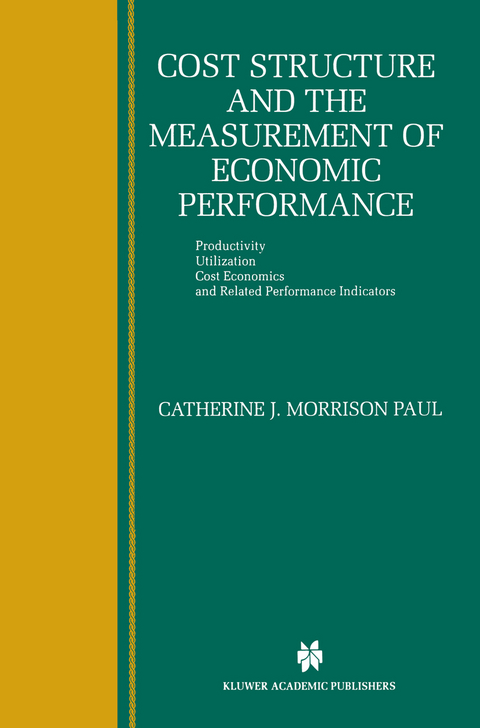
Cost Structure and the Measurement of Economic Performance
Springer (Verlag)
978-0-7923-8403-8 (ISBN)
The format of the book stresses topics or questions of interest rather than the theoretical tools for analysis. Traditional productivity growth modeling and measurement practices that result in a productivity residual often called the `measure of our ignorance' are initially overviewed, and then the different aspects of technological, market and regulatory structure that might underlie this residual are explored. The ultimate goal is to decompose or explain the residual, by modeling and measuring a multitude of impacts that determine the economic performance of firms, sectors, and economies.
The chapters are organized with three broad goals in mind. The first is to introduce the overall ideas involved in economic performance measurement and traditional productivity growth analysis. Issues associated with different types of (short and long run, internal and external) cost economies, market and regulatory impacts, and other general cost efficiencies that might impact these measures are then explored. Finally, some of the theoretical, data construction and econometric tools necessary to justify and implement these models are emphasized.
to the Conceptual Framework.- 1 What do “Economic Performance” and “Productivity” Mean?.- 2 Productivity Growth Components.- 3 Technical Change.- 4 The Cost Structure.- 5 Market and Regulatory Structure.- 6 Basics of Productivity Measurement.- Traditional Productivity Growth Measurement.- 1 Single-Factor Productivity Measures.- 2 Multifactor Productivity Measures.- 3 Growth Accounting.- 4 Technical Change and Productivity.- 5 Primal and Dual Measures.- 6 Technical Change Determinants.- 7 Technical Change Biases.- 8 Further Remarks.- The Short Run, Capital, and Capacity Utilization57.- 1 Short Run Fixities and CU.- 2 A Primal Economic CU Representation.- 3 A Dual CU Measure.- 4 Fixity, Adjustment Costs, and Dynamics.- 5 Capital Composition and Services.- 6 Further Remarks.- Short and Long Run Scale and Other Cost Economies.- 1 Components of the Cost-Output Relationship.- 2 Cost Economies vs. Technical Change.- 3 Scale Biases.- 4 Cost Economies More Generally.- 5 Further Remarks.- Internal and External Cost Economies, and Growth.- 1 A Model with External Effects.- 2 Returns to Public Capital.- 3 “Knowledge Capital” and Spillovers.- 4 Utilization and Scale Interactions.- 5 Microfoundations and Macro Models.- 6 Further Comments.- Market Structure and Economic Performance.- 1 Market Power Modeling.- 2 Market Power and Economic Performance Measures.- 3 Input Market Power: Monopsony.- 4 Market Power Measures and Welfare.- 5 Further Comments.- Regulatory Structure and Costs.- 1 Capital Regulations and Costs.- 2 Restrictions on Input Use: Pesticides.- 3 Lack of Markets: “Bad” Outputs.- 4 Regulation and Market Power.- 5 Further Comments.- Technical Efficiency.- 1 Frontier Modeling.- 2 Empirical Specification.- 3 Dual Models.- 4 Productivity and Efficiency.- 5Further Comments.- Underlying Theory and Implementation Issues.- 1 The Basic Production Theory Model.- 2 Production and Cost Structure.- 3 Profit Maximization.- 4 Dynamic Adjustment.- 5 Distance and Revenue Functions.- 6 Measures Representing Firm Behavior.- 7 Further Comments.- Data Construction for Estimation and Measurement.- 1 Non-Capital Output and Input Data.- 1.1 output production.- 2 Capital Data Construction.- 3 Aggregation Issues.- 4 Further Comments.- Issues of Econometric Implementation.- 1 Empirical Specification.- 2 Functions for Empirical Analysis.- 3 Functional Forms.- 4 Some Econometric Issues.- 5 Further Comments.- Pulling It Together.
| Zusatzinfo | XIV, 363 p. |
|---|---|
| Verlagsort | Dordrecht |
| Sprache | englisch |
| Maße | 155 x 235 mm |
| Themenwelt | Wirtschaft ► Volkswirtschaftslehre ► Mikroökonomie |
| ISBN-10 | 0-7923-8403-2 / 0792384032 |
| ISBN-13 | 978-0-7923-8403-8 / 9780792384038 |
| Zustand | Neuware |
| Haben Sie eine Frage zum Produkt? |
aus dem Bereich


